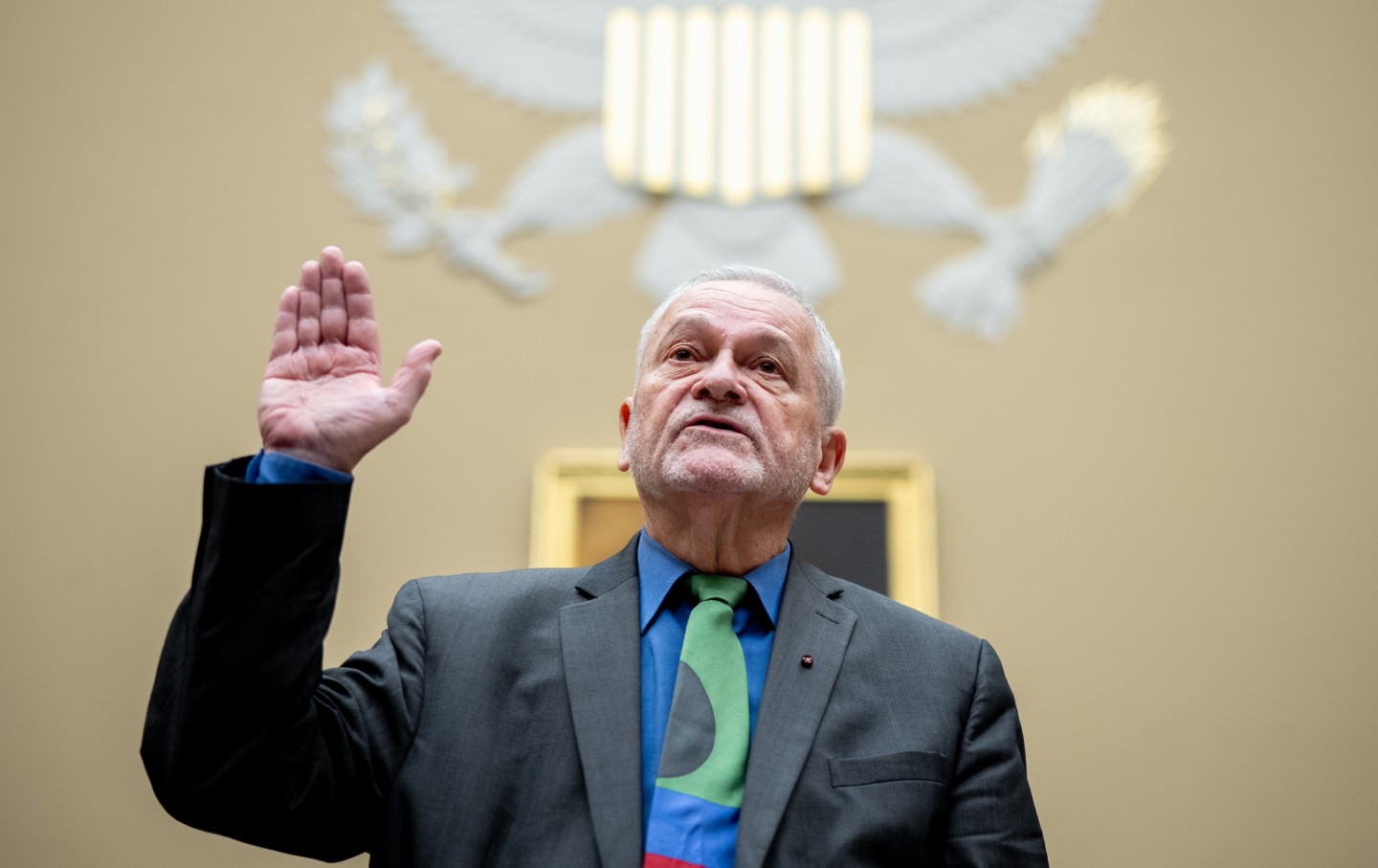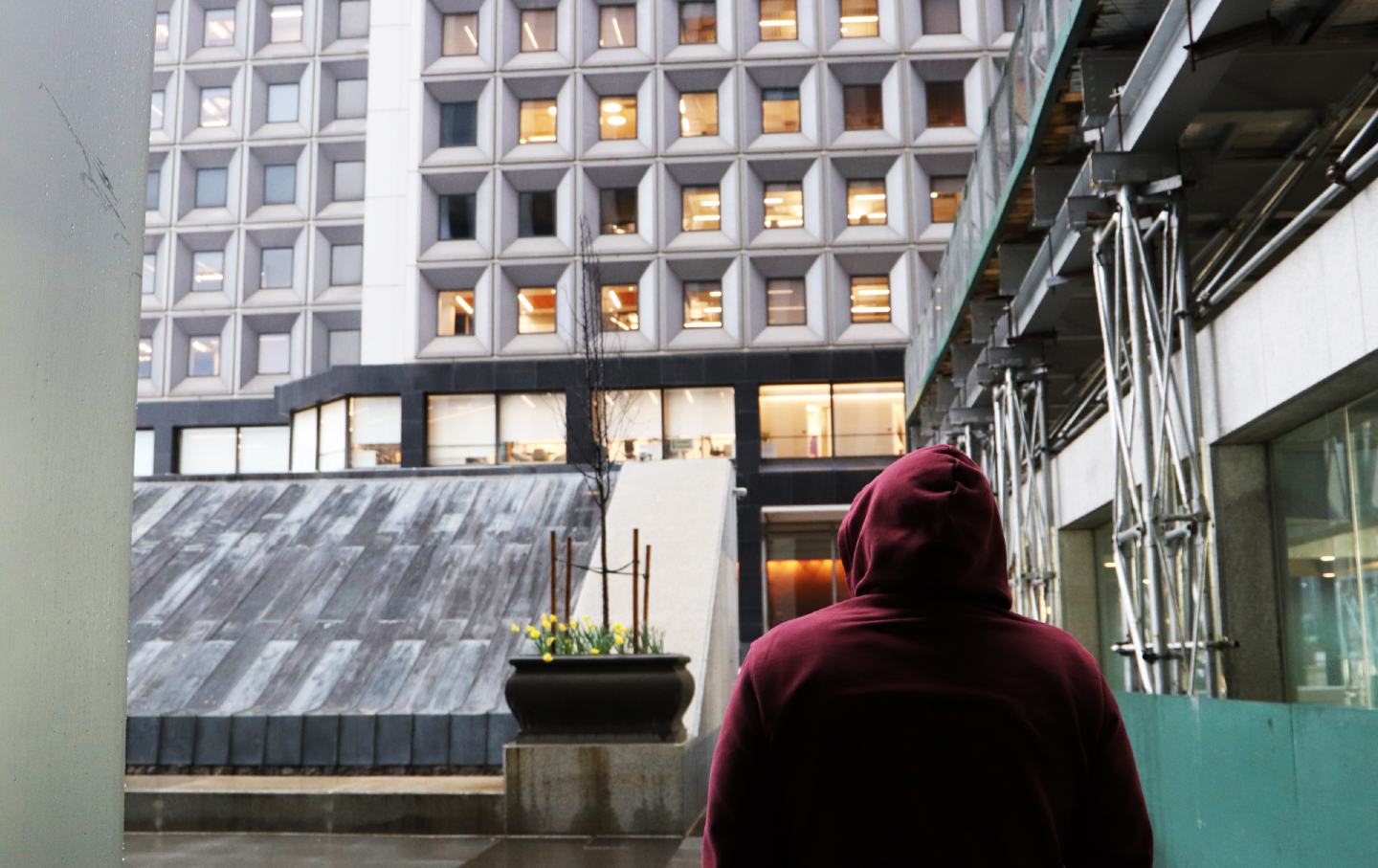MG’s cousin was running late for lunch. He walked to pass the time, as anyone might, around the East Harlem neighborhood where they’d agreed to meet up. As he turned a corner, MG saw something that froze him mid-step: a school.
“I’m just stuck here like a deer in the headlights. Like where should I go?” MG recalled. He hurried away, walked a couple of blocks, then made another turn. Another school.
“I just went into a store and hid,” he said. He sipped on a coffee until his cousin showed up.
Under New York state law, MG isn’t allowed to step—let alone live or work—within 1,000 feet of school grounds. In a dense area like New York City, where the 52-year-old has lived most of his life, it’s virtually impossible to comply with the restriction: It applies to some 85 percent of residential areas in the city. In Manhattan, it’s 95 percent.
The New York Civil Liberties Union filed a federal class-action lawsuit on Tuesday, on behalf of MG and three other anonymous plaintiffs, seeking to overturn the law imposing what it calls the “banishment zone.” Known as the Sexual Assault Reform Act, or SARA, the law went into effect almost 25 years ago—part of the state legislature’s response to the sex-offender panic that had swept the nation.
The law bans thousands on the state sex offense registry from entering school zones. Its language is sweeping—applying to some, like MG, whose offenses weren’t sexual. According to the lawsuit, he confronted a group of kids during an intoxicated mental breakdown and grabbed one of them, landing him kidnapping and unlawful imprisonment convictions—two broadly defined, nonsexual offenses that can put someone on the registry.
MG has a wife, five children, and a church community on Staten Island, but he has to live over an hour away. He spends his nights in a homeless shelter on Wards Island, in the middle of the East River, where there are no schools—and few jobs, scant access to transit, and little opportunity.
“I don’t know where I can actually go sometimes,” he said. “I’m so extra cautious, paranoid of going back to prison for this nonsense.”
SARA’s application is mercurial. MG said parole officers have given him conflicting guidance on where he’s allowed to go—a common complaint, according to civil rights attorneys.
That nebulousness prompted the NYCLU to argue that SARA is “vague, expansive, and unnecessary,” violating the Constitution’s 14th Amendment. If the suit prevails, it would leave New York’s sex offense registry intact, but eliminate the 1,000-foot rule for schools.
While advocates have found little success fighting SARA in New York courts, there’s precedent for change at the federal level. In 2016, a federal appeals court ruled that Michigan’s sex offense registration law was unconstitutional, specifically citing a provision that prevented registrants from living, working, or “loitering” within 1,000 feet of a school. The state appealed to the Supreme Court, which declined to take on the case. Last year, a federal judge ruled that Rhode Island’s 1,000-foot residency restriction was unconstitutionally vague.
“Individuals subject to SARA have no idea where they can walk, commute, or live,” the NYCLU charges in its federal lawsuit, “without fear of reincarceration.”
On the heels of the 1990s sex offender panic and the Clinton Crime Bill, every state and the federal government created registries, most of them public, of those convicted of sex offenses. As an addendum to New York’s sex offense registration law, SARA applies the 1,000-foot rule to parolees on the registry whose victims were minors, as well anyone a judge deems at the highest risk of re-offending, no matter their victim’s age.
Researchers have argued that such restrictions do little to deter sex crimes. Studies focused on Missouri, Michigan, and Florida have found that they have little to no effect on sex offense recidivism, and the US Department of Justice has acknowledged that there is “no empirical support” for the notion that the restrictions serve as a deterrent. In 2017, under the Trump administration, the Justice Department wrote that severe restrictions can instead carry “unintended consequences,” such as the loss of housing and social stability, that “aggravate rather than mitigate offender risk.”
According to SARA’s opponents, the law is counterproductive from a public safety perspective. New York’s parole officers are already allowed to tailor parole conditions to a number of factors, including proximity to “vulnerable populations.”
“What SARA does is force [the parole system] to impose a blanket restriction on everyone subject to the statute, without regard to whether that restriction makes sense,” Lisa Napoli, director of policy and strategic litigation for Appellate Advocates, told New York Focus last year.
Popular
“swipe left below to view more authors”Swipe →
Those indiscriminate limitations make it nearly impossible for SARA-restricted parolees to accomplish basic survival tasks, like finding a job and housing. And it cuts many, like MG, off from their support systems.
JL, another plaintiff, lives in a shelter in the Bronx. He was able to find work as a paralegal, and has been saving up for an apartment, but he can’t find a place that his parole officer will approve. He said he’s submitted dozens of addresses, including at least five that, by the NYCLU’s “most conservative possible measurement,” are over 1,000 feet from a school. His parole officer rejected all of them, without explaining why.
In the shelter, JL gets assigned roommates, and he has to be through the building’s metal detectors by 11 pm or he loses his bed. The staff do a count, then turn out the lights. If he has to work late on a case, he does it on his laptop, in the dark.
“Everytime I walk into the shelter, it’s like walking back into the prison,” he said.
JL and MG are at least lucky to be out. As New York Focus and The Nation reported last year, New York has kept hundreds of those who can’t find SARA-compliant accommodations imprisoned, even past their maximum release dates. The prison agency says it transfers them to a “residential treatment facility.” In reality, officials move them to a different prison. They wear prison uniforms, are subject to prison rules, and most live in general population units—until they can find housing, which is made all the more difficult by prisons’ limited access to the Internet and newspapers. And the prison department has argued that it isn’t required to help them.
The Department of Corrections and Community Supervision, which oversees the state’s prison and parole systems, did not respond to a request for comment before press time.
The NYCLU’s federal lawsuit follows repeated appeals to state courts to overturn various facets of SARA, including the “residential treatment facility” regime. They’ve largely failed.
A majority of judges on New York’s top court have expressed skepticism of reducing punishments for sex offenses. Some advocates were hopeful last year when, after years of relatively conservative majority control on the court, the state Senate confirmed a new chief judge known for defendant-friendly rulings. But while the court has staked out a more progressive direction on defendants’ rights generally, it has largely stayed the course on the politically charged and unpopular subject of sex offenses.
“People convicted of sex offenses are nuclear. Nobody wants to touch it,” said Napoli of Appellate Advocates.
In one 4–3 decision last year, the court rejected one man’s claim that subjecting him to SARA’s restrictions was unconstitutional since the law didn’t exist when he committed his crime in 1986. He couldn’t find housing far enough from a school, leading the prison department to keep him incarcerated for nearly two years after his scheduled release date.
In another case last year, the court unanimously rejected a defendant’s request for an exemption from the 1,000-foot rule based on his being 18 at the time of his crime, and therefore a candidate for a more lenient “youthful offender” sentence.
The court has made some decisions in favor of sex offense defendants, but they’ve been too limited to alter the state’s applications of SARA. Last year, the court heard the case of a man who robbed his aunt at gunpoint in the presence of his 10-year-old cousin and pled guilty to “unlawful imprisonment of a child.” Citing a 2009 case, lower courts forced him to register as a sex offender, even though there was no sexual contact involved in the crime.
The high court overturned his sex-offender registration by a vote of 4–3, but didn’t overturn the 2009 case, leaving cases of other sex offense registrants with nonsexual convictions, like MG’s, untouched.
The Original Investigation:
-
They Were Supposed to Be Free. Why Are They Locked Up?
In another recent 4–3 case, the court found that the state prison agency must attempt to secure educational or professional opportunities for people it holds after their release dates. But, as with previous cases, it rejected arguments that keeping people incarcerated after they’ve completed their sentence is unconstitutional.
“We thought we had something that could take down the [residential treatment facility] confinement system for sex offenders,” said James Bogin, senior supervising attorney at Prisoners’ Legal Services, one of the organizations that filed the case in 2016. “It seems like we’ve largely exhausted the possibilities of what the state courts can do.”
So the NYCLU has upped the ante: By asking a federal court to find SARA unconstitutional, it seeks to strike the law down altogether. Beyond eliminating the 1,000-foot rule, the move would force the state to reconsider its approach to reintegrating sex offense registrants.
“The restrictions—they do nothing,” said JL. The state is “ostracizing people,” he said, “making it so hard to live that you’re making some people want to give up.”
Thank you for reading The Nation!
We hope you enjoyed the story you just read, just one of the many incisive, deeply reported articles we publish daily. Now more than ever, we need fearless journalism that moves the needle on important issues, uncovers malfeasance and corruption, and uplifts voices and perspectives that often go unheard in mainstream media.
Donate right now and help us hold the powerful accountable, shine a light on issues that would otherwise be swept under the rug, and build a more just and equitable future.
For nearly 160 years, The Nation has stood for truth, justice, and moral clarity. As a reader-supported publication, we are not beholden to the whims of advertisers or a corporate owner. But it does take financial resources to report on stories that may take weeks or months to investigate, thoroughly edit and fact-check articles, and get our stories to readers like you.
Donate today and stand with us for a better future. Thank you for being a supporter of independent journalism.
Thank you for your generosity.
More from The Nation
“I don’t want to leave you behind, but we can’t see any other way, Noor,” Mama said. “We are so tired. We cannot bear it anymore.”
Noor Alyacoubi

By the end of the century, the world could lose almost half of its sandy beaches. But a movement of surfers across Latin America is working to protect the coastal-marine environme…
StudentNation
/
Ilana Cohen

Matt Stoller and Stacy Mitchell discuss the battle against monopoly power.
Q&A
/
Laura Flanders

After a top aide to Anthony Fauci was grilled by Congress, questions emerge as to whether others may have sought to avoid transparency around the Covid epidemic.
Jimmy Tobias

The president is canceling student loan debt in batches of thousands, but the need is in the millions. It’s costing him the voters he needs most.
Eleni Schirmer
